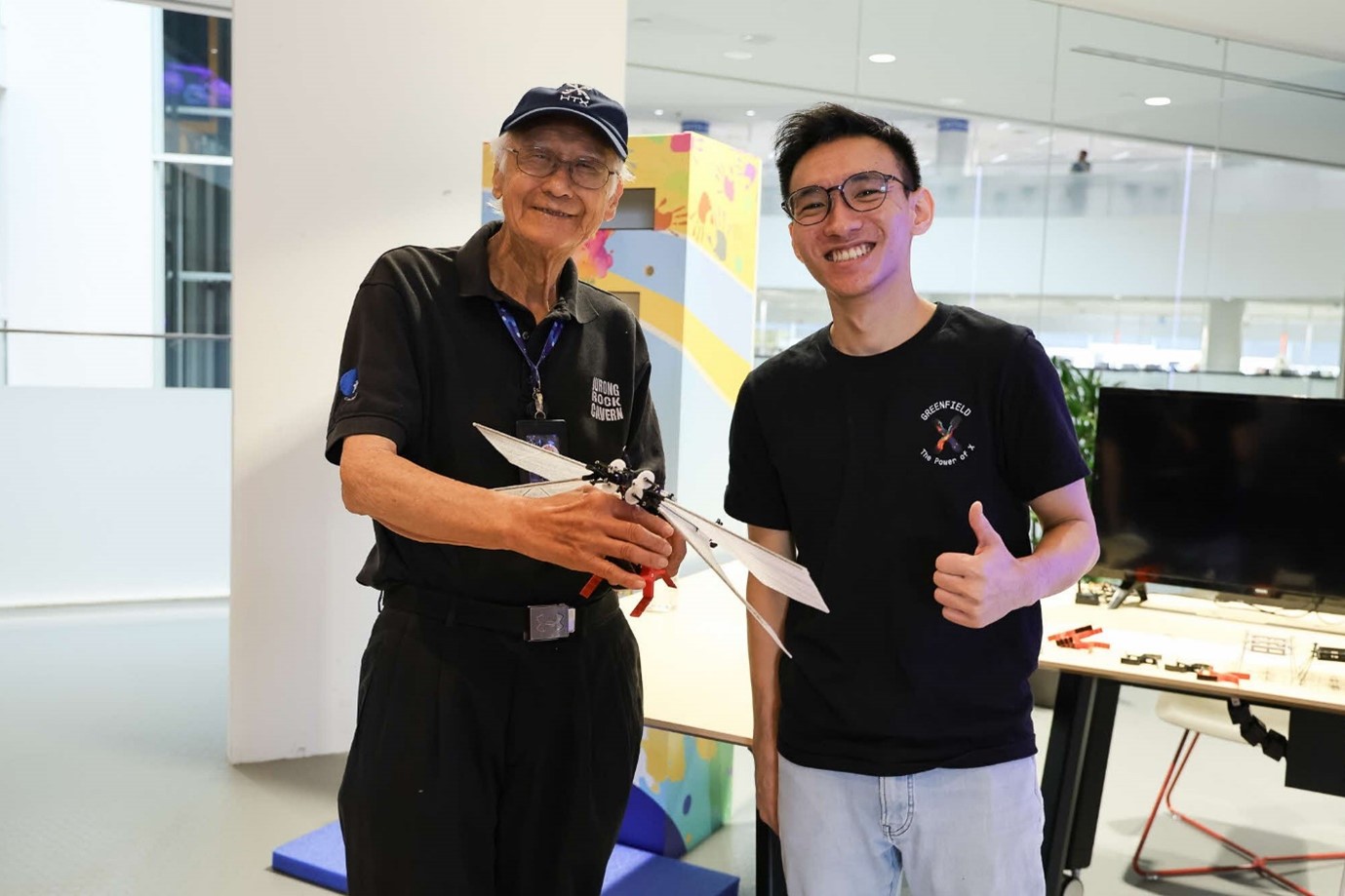 Joseph (right) explains the use of the ornithopter to Professor Lui. (Photo: HTX/Law Yong Wei)
Joseph (right) explains the use of the ornithopter to Professor Lui. (Photo: HTX/Law Yong Wei)
Mention the term “ornithopter” and the first thing that would probably come to the mind of a science fiction buff would be the iconic bird-like machine from the Dune universe that flies by flapping its wings.
Well, such a machine actually exists in HTX. And get this – our version does more than fly.
It can even crawl.
The brainchild of Joseph Wong, an engineer from HTX’s Robotics, Automation and Unmanned Systems Centre of Expertise (RAUS CoE), this innovation was showcased at HTX’s latest Greenfield Showcase and Associates’ Graduation Ceremony on 7 October 2025.
The showcase was the culmination of year-long efforts undertaken by the 2022 batch of HTX Associates and Scholars to design and pitch science, engineering and digital solutions for Singapore’s public safety.
The 14 greenfield projects showcased at the event were aimed at addressing important public safety questions with transformative approaches.
For Joseph, the question he chose to tackle was: “What if the next-gen drone didn’t just fly – but could also crawl right up to you at a disaster site?”
Why would such a machine be needed? Think search and rescue.
In situations such as a collapsed building where searching for survivors from the air might be impossible, this hybrid robot can crawl through spaces in the debris and even climb smooth vertical surfaces.
Made up of a flapping-wing drone and a wheg-based crawler, this ornithopter is equipped with a lightweight camera that can feed real-time video footage to its operator.
“While this technology still feels nascent, I am excited to see what small aerial robots augmented by AI can achieve in the next few years, especially in cluttered or confined environments where conventional drones face limitations.”
This project snagged the Enterprising eXplorer Award for its innovativeness.
Toxic gas leak in the open! Where would you go to hide?
If such a scenario does occur, you’d likely find Liang En Rui from the Chemical, Biological, Radiological, Nuclear and Explosives (CBRNE) CoE hiding within his very own creation – RapidShield.
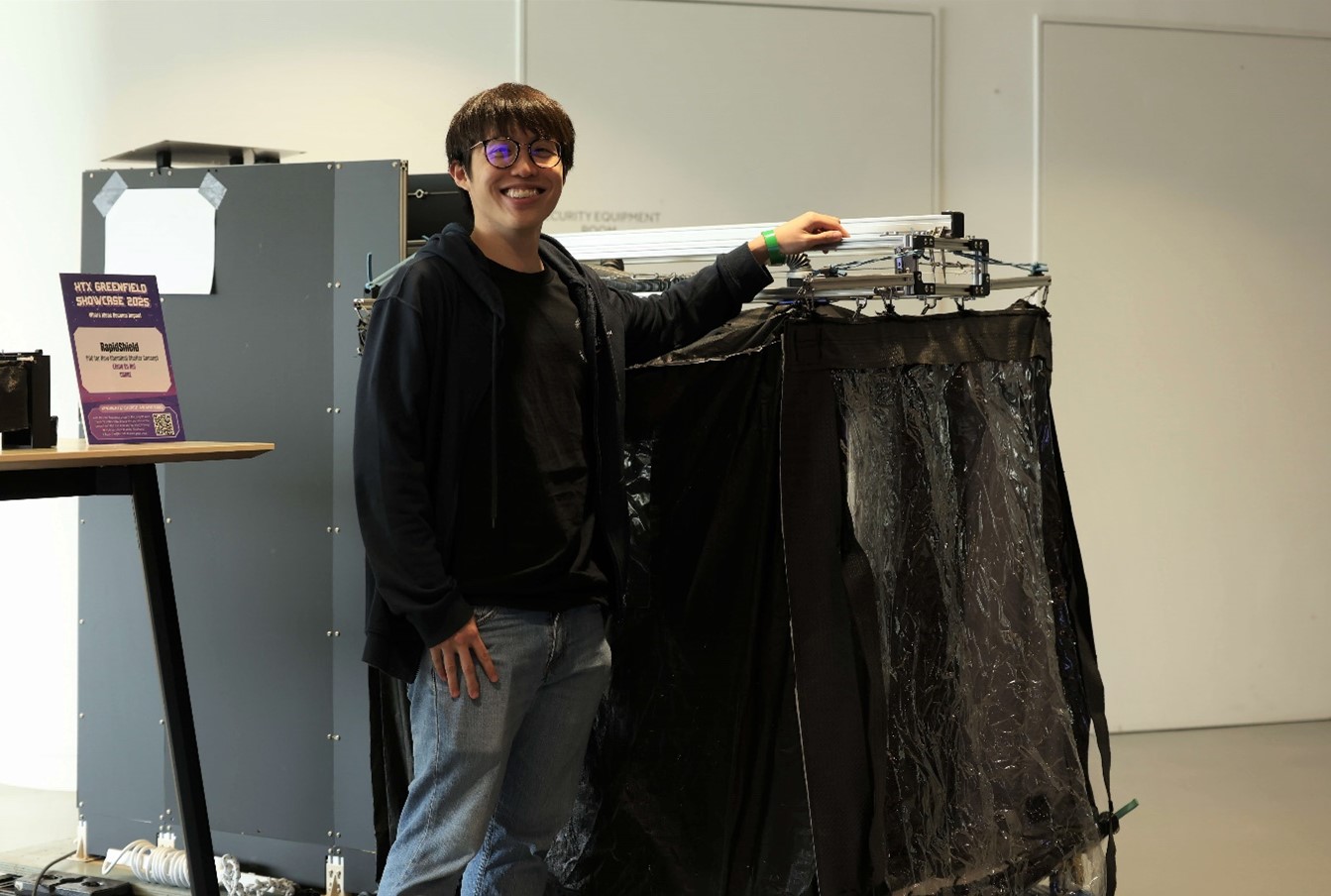 En Rui poses with the POC of RapidShield. (Photo: HTX/Janna Giam)
En Rui poses with the POC of RapidShield. (Photo: HTX/Janna Giam)
A self-deployable tent that pops up with just a click of a button, RapidShield was the result of En Rui’s collaboration with final-year undergraduates from the Singapore University of Technology and Design (SUTD).
Such a solution, he explained, would be especially suitable for remote locations where built infrastructure is far and few between.
The dark web is a massive and scary place. How can we tell if sensitive public safety information has made its way there?
Enter “DarkAnalytix” (previously “DumpSieve”), an AI-powered automated platform used to monitor, alert and triage data leaks and ransomware incidents affecting the supply chain of an organisation – and in this case, the Home Team.
“With this tool, we could provide answers in times of uncertainty, like when there’s been an attack on a third party in a HTD’s supply chain and it is not yet known if the HTD’s data has been compromised,” explained Sean Saw, an HTX Scholar and the brains behind DarkAnalytix.
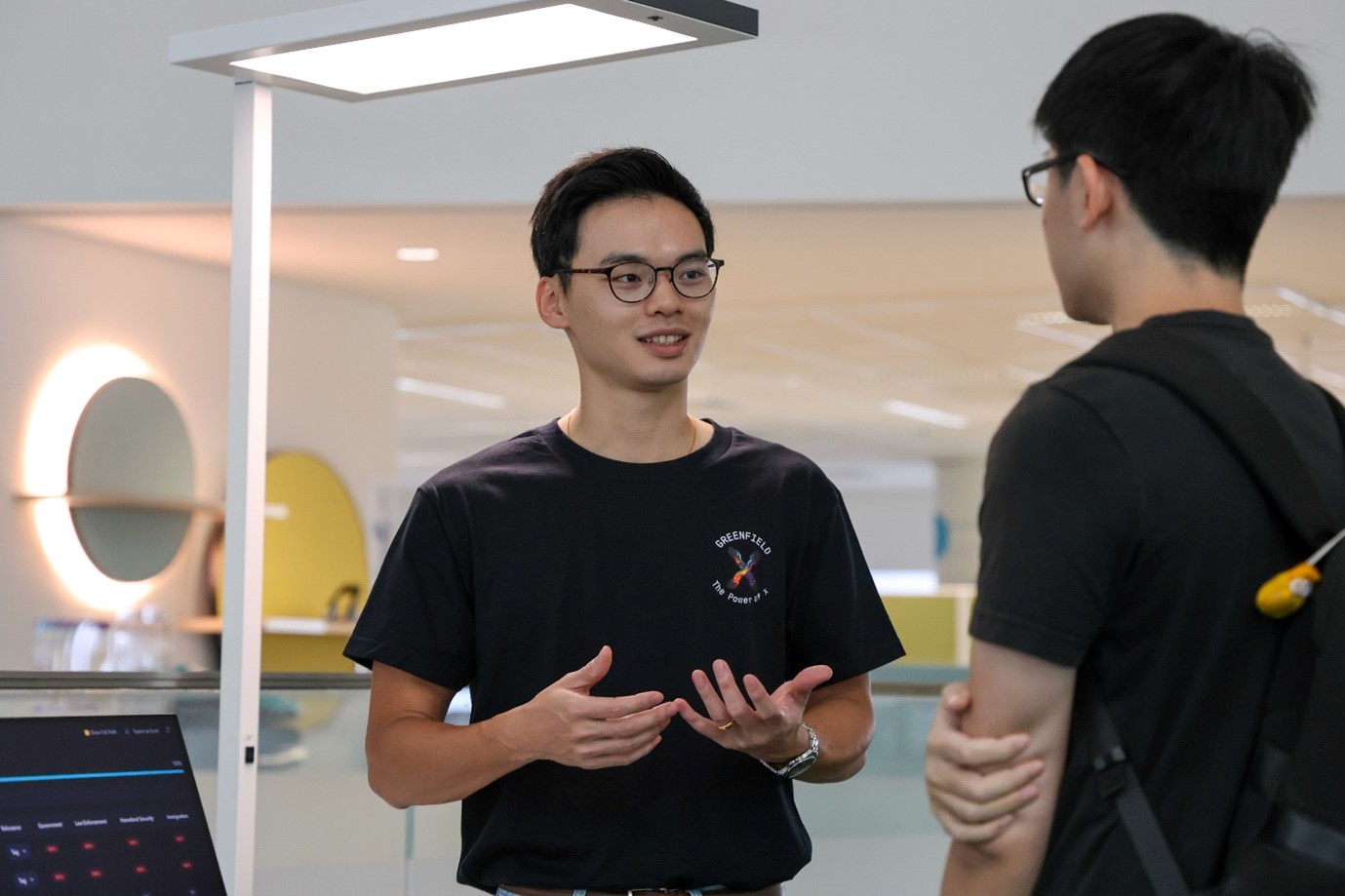 Sean (left) explains the processes powering DarkAnalytix to a fellow Xponent. (Photo: HTX/Dorcas Yang)
Sean (left) explains the processes powering DarkAnalytix to a fellow Xponent. (Photo: HTX/Dorcas Yang)
The solution has already shown potential to strengthen the Home Team’s cybersecurity posture, and has even gained bragging rights by making its debut at Black Hat USA 2025, a high-profile international cybersecurity convention.
“I only recently started working with Artificial Intelligence (AI) models. To have one of the tools I built shown to an international audience is a huge honour, and also a win for HTX,” Sean previously commented.
Sean walked away with the LearnXpreneur Award for embodying the spirit of learning and resourcefulness in the face of challenges and failure.
Question: Could your contact lenses interfere with facial recognition?
Iris scans are often used in official biometrics enrolment and verification processes carried out by the Home Team. While current systems in the market may be able to detect the use of cosmetic contact lenses (such as those that alter the appearance, colour or size of one’s eyes), capabilities to detect transparent contact lenses are not quite on a par yet.
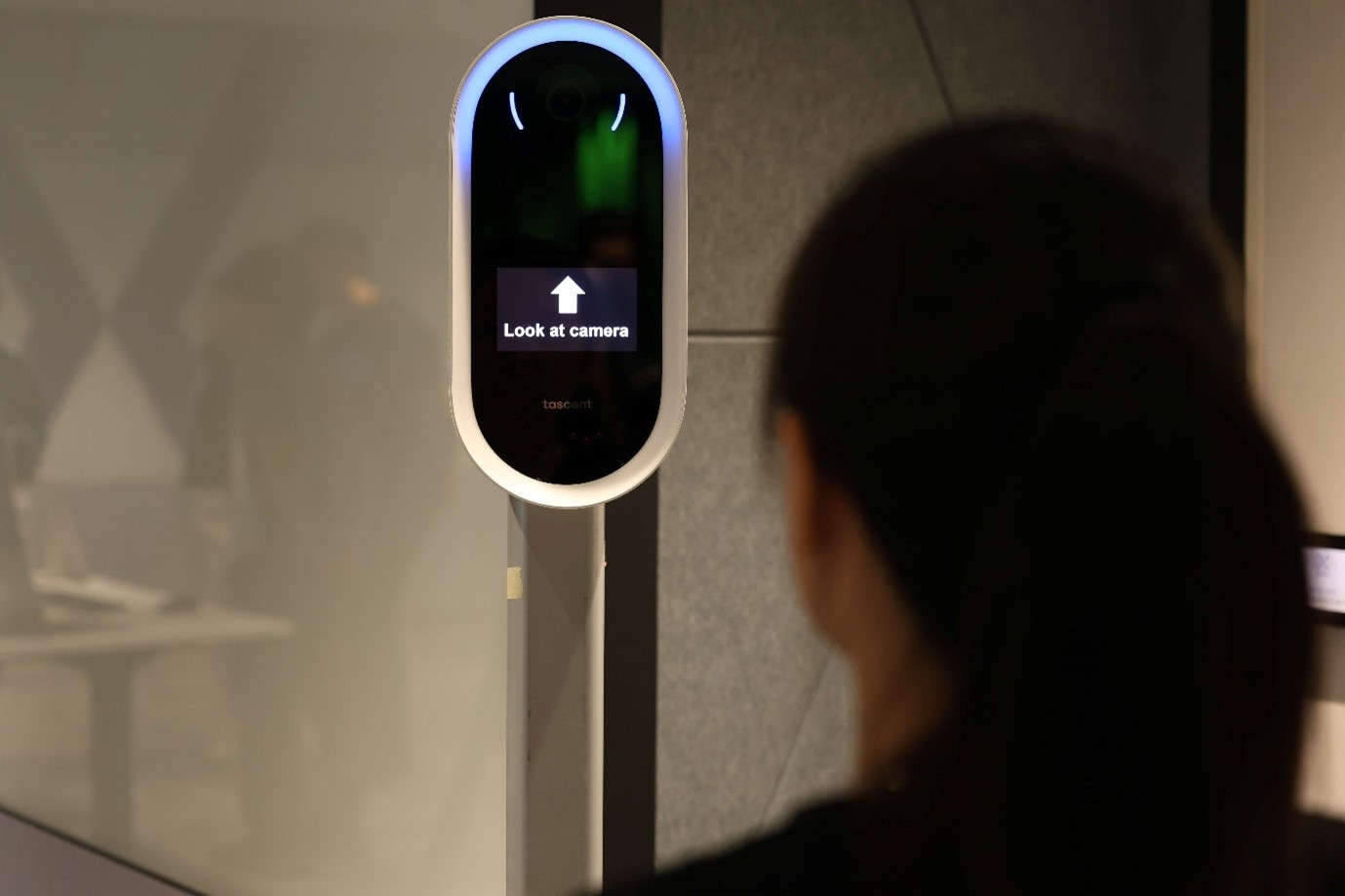 Averie demonstrates the use of an iris scanner on a user wearing contact lenses. (Photo: HTX/Janna Giam)
Averie demonstrates the use of an iris scanner on a user wearing contact lenses. (Photo: HTX/Janna Giam)
Tackling this problem is Averie Low from the Biometrics and Profiling CoE, whose response is the “The Masked Iris”, a solution that employs a variety of AI enhancement strategies – from unconventional image processing to neural networks – to improve the detection of both types of contact lenses.
Recognised for its potential to impact the Home Team’s operations and outcomes, Averie’s project received the Potentialx Award.
The judges of the greenfield projects were certainly impressed with what they saw.
“We’ve seen very interesting and novel ideas from the associates today, projects which could be practical for the Home Team to adopt. It’s good to see that they haven’t been constrained by existing ideas or concepts,” said Theodore Tan, Director Operations, Technology Division, Immigration and Checkpoints Authority (ICA).
“As they continue to undertake these projects, I look forward to seeing how they can be further applied to Home Team operations, where speed and time have always been important.”
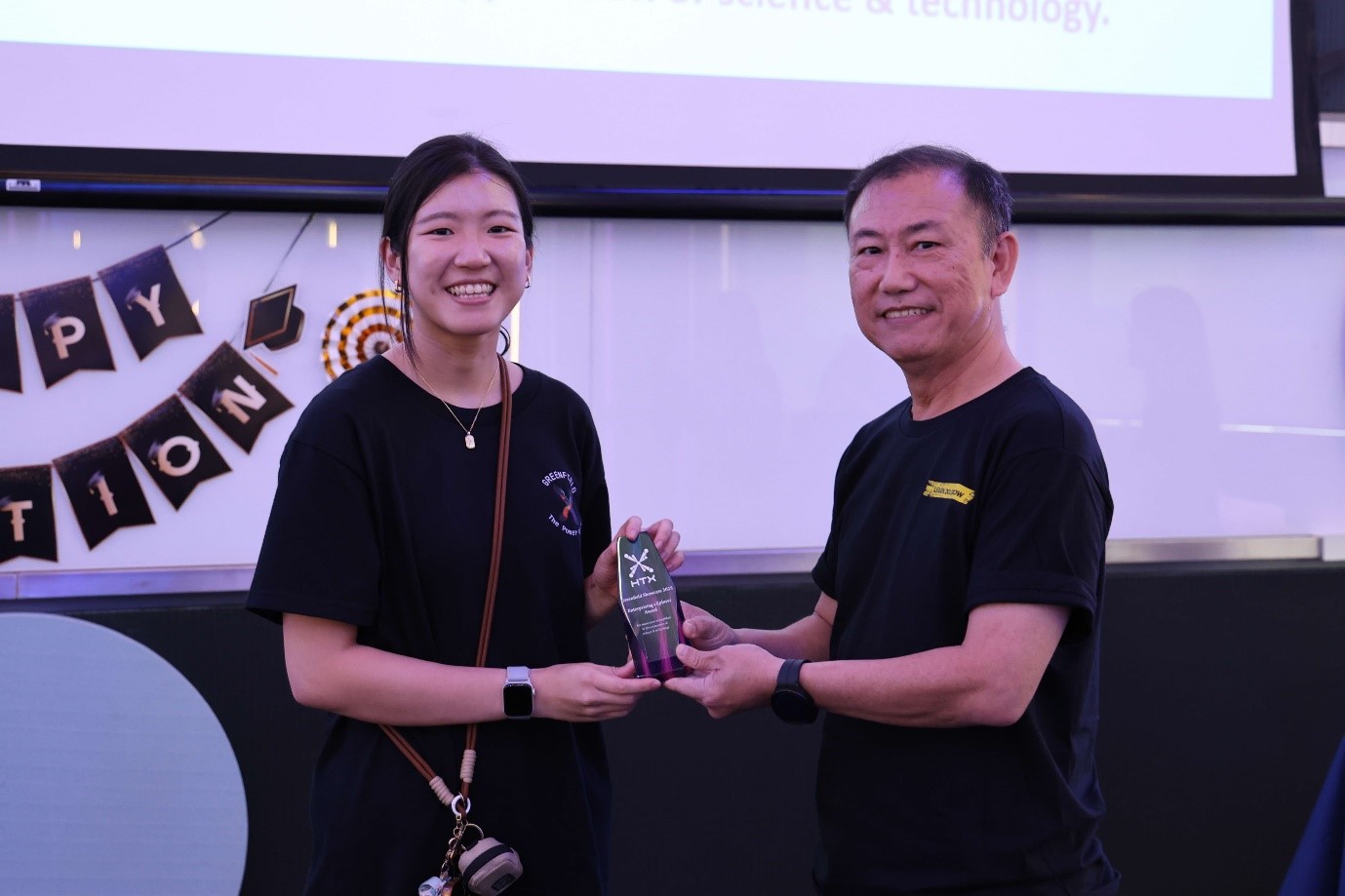 Lydia He (left) from the Partnerships division and Hatch, HTX’s innovation centre, takes home the Enterprising eXplorer Award for her Analyst Co-Pilot project – a web application that performs automatic web searches and information gathering on start-ups. (Photo: HTX/Dorcas Yang)
Lydia He (left) from the Partnerships division and Hatch, HTX’s innovation centre, takes home the Enterprising eXplorer Award for her Analyst Co-Pilot project – a web application that performs automatic web searches and information gathering on start-ups. (Photo: HTX/Dorcas Yang)
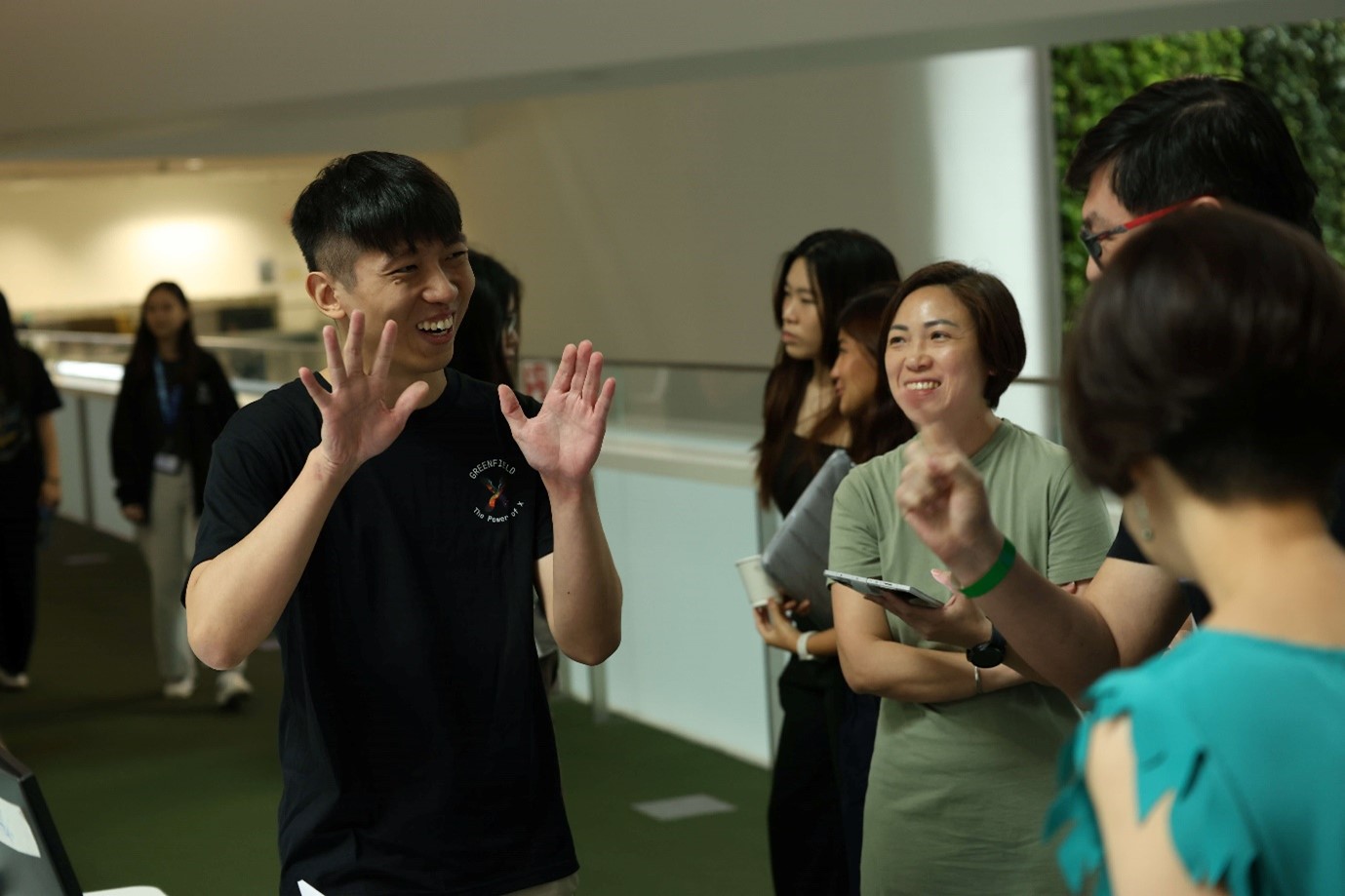 He Cheng Hui (left) from the Q Team CoE receives the Potentialx Award for FaceSense, a unified, in-house multi-task facial analysis model capable of performing facial landmarks prediction, head pose estimation, and race and gender classification simultaneously from a single face image. (Photo: HTX/Janna Giam)
He Cheng Hui (left) from the Q Team CoE receives the Potentialx Award for FaceSense, a unified, in-house multi-task facial analysis model capable of performing facial landmarks prediction, head pose estimation, and race and gender classification simultaneously from a single face image. (Photo: HTX/Janna Giam)
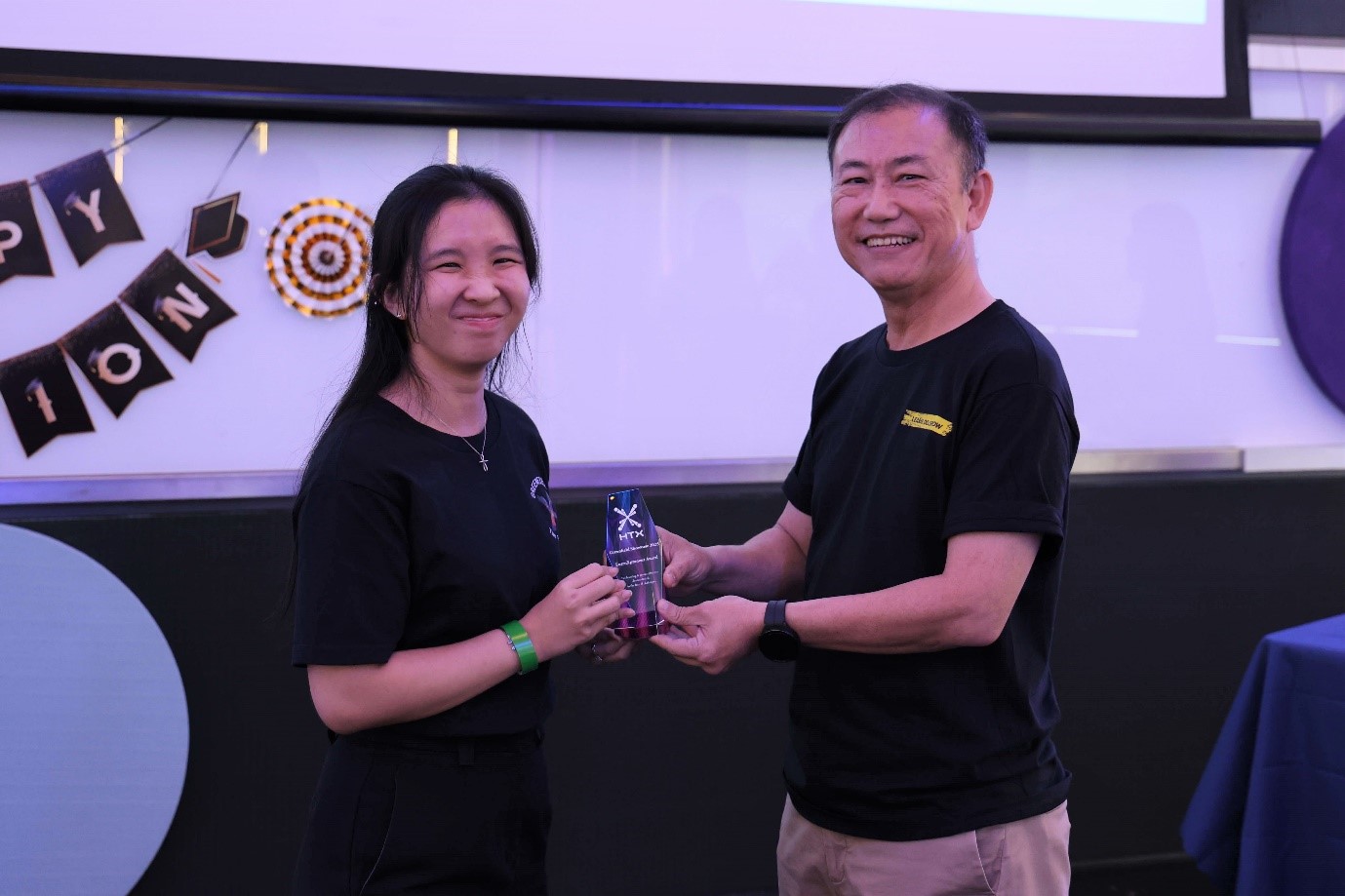 Keller Chai (left) from the Human Factors and Simulation CoE receives the LearnXpreneur Award for her dare-to-try spirit from HTX Deputy Chief Executive (Operations) Chen Yeang Tat. (Photo: HTX/Dorcas Yang)
Keller Chai (left) from the Human Factors and Simulation CoE receives the LearnXpreneur Award for her dare-to-try spirit from HTX Deputy Chief Executive (Operations) Chen Yeang Tat. (Photo: HTX/Dorcas Yang)
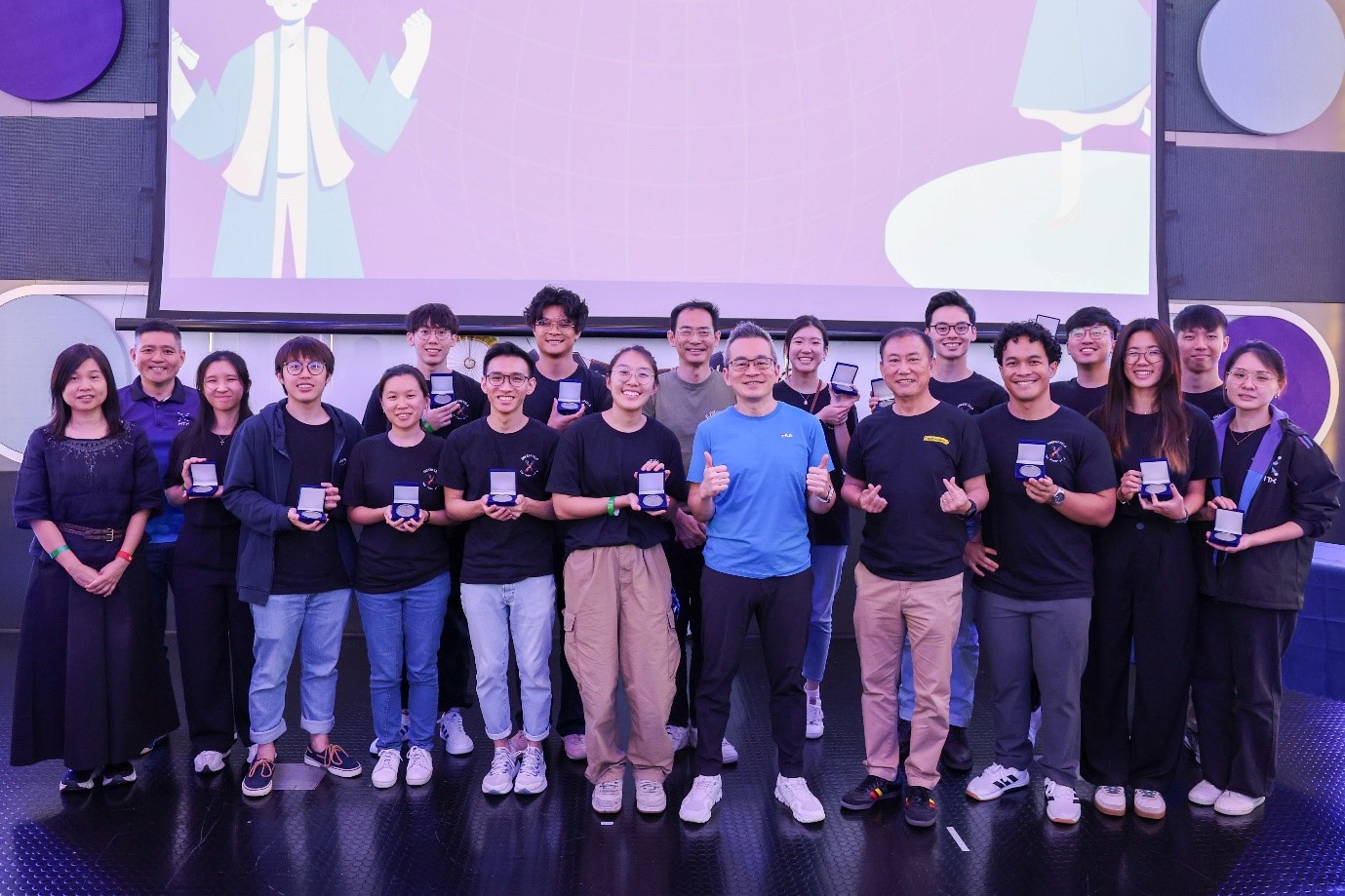 Our young talent who started their journey with HTX in 2022 pose with HTX’s senior management. (Photo: HTX/Dorcas Yang)
Our young talent who started their journey with HTX in 2022 pose with HTX’s senior management. (Photo: HTX/Dorcas Yang)
This year’s Greenfield Showcase and Associates’ Graduation Ceremony was part of HTX’s biennial Learning and Innovation Festival, which was themed, “Reimagining Learn. Do. Grow in the age of Artificial Intelligence (AI)”.
The Keynote speaker of the event, Professor Lui Pao Chuen, Singapore’s first Chief Defence Scientist, emphasised during his presentation the importance of transformation in learning, doing and growing – a concept he said is “an even more powerful idea than innovation”.
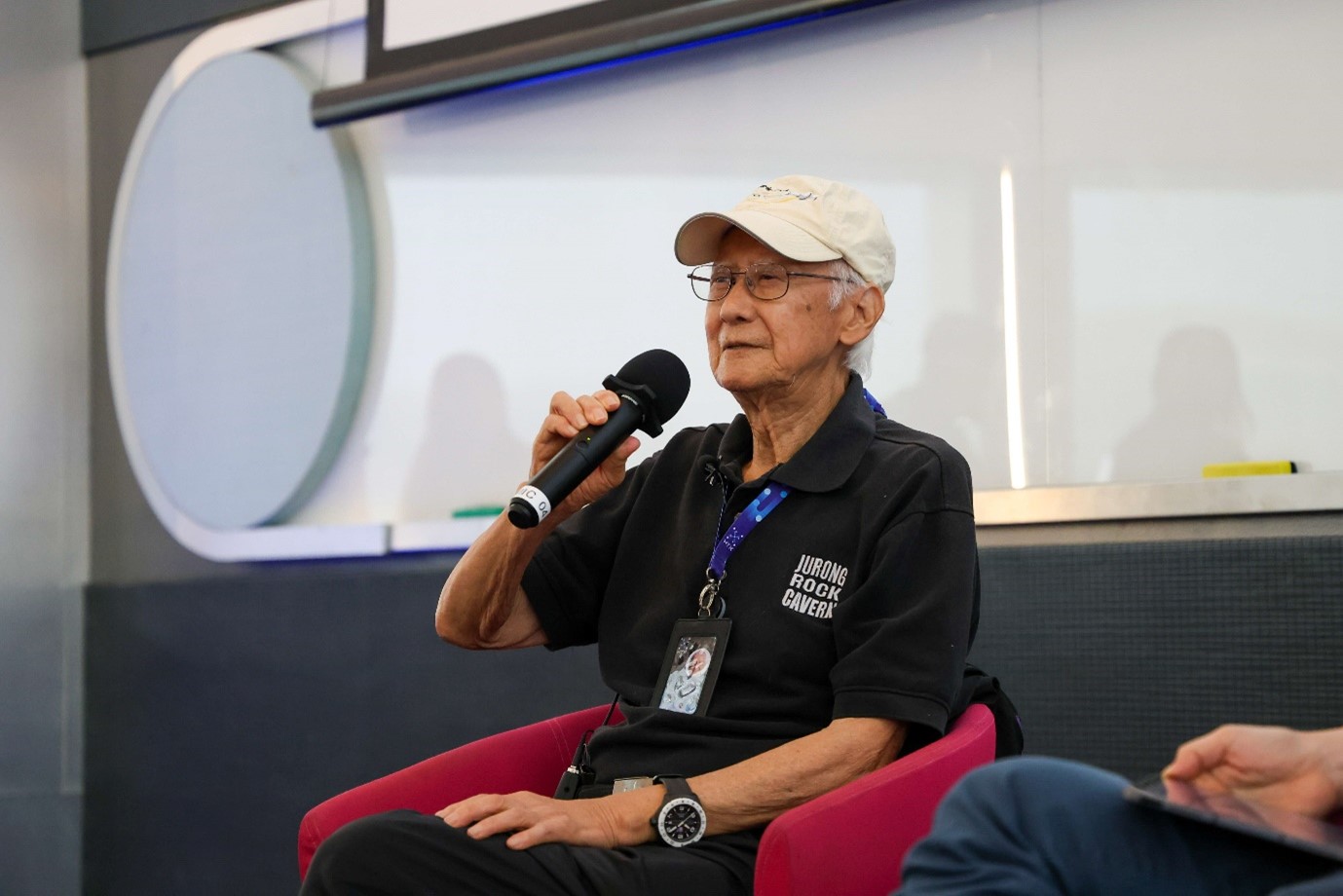 Professor Lui Pao Chuen shared a multitude of success stories, both in his personal journey and in modernising Singapore’s defence technology. (Photo: HTX/Dorcas Yang)
Professor Lui Pao Chuen shared a multitude of success stories, both in his personal journey and in modernising Singapore’s defence technology. (Photo: HTX/Dorcas Yang)
He also shared how Singapore’s defence sector has thrived by embracing transformation and why it is important to dare to try even after failure, noting that these traits were what paved the way for the innovative defence technology solutions protecting Singapore today.
Inspired to build your own piece of meaningful tech?
Check out our Associate Programme and learn how you too can make an impact on Singapore’s public safety with HTX.

![[FEATURED NEWS] HTX Associates’ Graduation 2023](/Cwp/assets/htx/images/listing-card-placeholder.png)